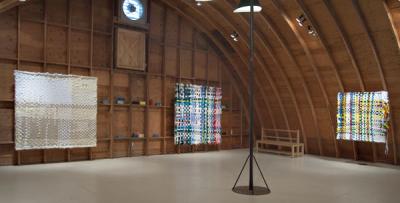Homespun Adventures

In “Loop Holes,” Louise Eastman’s homespun weavings and cast bricks look perfectly at home in the barn that houses the Silas Marder Gallery exhibition space in Bridgehampton. Yet they would look equally at home in some of the South Fork’s remaining untouched classic midcentury ranches, complete with linoleum floors and Formica countertops.
On the one hand, there is such a feeling of Grand-ma-ma in the folksy construction of the wall works, mostly based on a popular weaving technique of the 1950s that churned out homemade potholders for home use or gifts. On the other, we see a contemporary artist’s embrace of fiber art, classic commercial craft, and the employment of color in a variety of bold, subtle, and neutral ways.
Ms. Eastman’s steadfast avoidance of canvas or paper, unless it’s two-ply and gentle on sensitive skin, or else has a sticky backing, is a laudable twist on conventional art-making that still hangs on a wall. Her experiments in sewing and weaving toilet paper, attaching masking tape to felt, and blowing up what one is used to seeing as 6-by-6-inch trivets into the size reserved for grand gestural paintings, force one to take note and enjoy their sunny unpretentiousness. At the same time, her organization of colors, while resolutely random, still stands out as aesthetically adept.
In her woven pieces she appears to work in two main categories, one titled “Potholder,” to underline the reference, and the other “Two-Ply,” which references the qualities of the materials she is using. The resulting forms may be complex colorful geometric abstractions or a strange Minimalist triad of Robert Ryman, Agnes Martin, and Anni Albers. The eye understands that it is looking at woven toilet tissue when gazing at “Two-Ply I,” yet the mind senses so much more in its delicate purity, intercut with thin reinforcing thread lines of many hues.
The floor pieces can be even more complex. They look like odd lots of yarn, and the artist suggests more is going on with them with their titles, each one called “Process.” These are interactive works, where the audience is invited to unravel the balls or add to them. In this way, “Process II” takes up much of the corner it is in, as if a giant spider on acid decided to make it into a web. A hand-cranked knitting machine is clamped to the gallery’s coffee table so that viewers may relax on the couch, enjoy the view outside the floor-to-ceiling garage door windows, and create and add their own material to the piece, which has now become enmeshed in the staircase up to the loft and woven down from that upper corner like a giant kid’s fort.
Jess Frost, who organized the show, said it has become an adventure to check the progress of the piece at each day’s end.
If the wall and floor pieces were not enough, the gallery is also adorned on several surfaces with cast ceramic “bricks.” The pieces, which appear as substantial and durable as the construction material, are actually quite lightweight and delicate. The result of an exhortation by one of Ms. Eastman’s graduate instructors to create something new every day, these pieces are exercises in both painting and sculpture, although the sameness of the cast brings the painting element front and center, and that is what varies from dull, drab exercises, to monochromatic ones, to delicate pastels, to deep violent reds, to black nothingness, and even brick-colored bricks. They are surprisingly satisfying and encourage purchase in multiples, an instant and engaging collection.
“Loop Holes” has been extended to close on Sunday.
